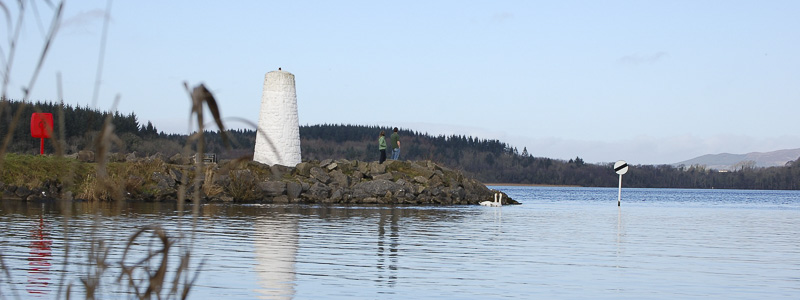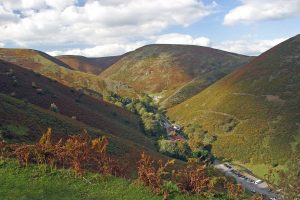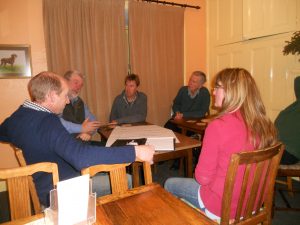By Julia Aglionby Executive Director - England, Foundation for Common Land
(in Volume 29)
The governance of pastoral common land in England has been a multi-layered and highly regulated affair for over 800 years since the Statute of Merton in 1235. In practice there is a huge variation in the success of common land units to deliver multiple outcomes even when regulatory systems are the same, land uses similar and the establishment of a local governance structure occurred at a similar date. This observation prompted a study into attributes of successful management across commons in five upland areas in England.
The project, ‘Better Outcomes on Upland Commons’ with 16 partners[1] from across conservation, land management and government had an underlying driver to explore how conflicts between interests, too often seen as competing, can be mitigated and co-delivery achieved. This article looks at one case study, the Long Mynd, where the common is heavily used for recreation purposes and considers the attributes of governance that successfully deliver recreation opportunities alongside those of conservation and agriculture.
The ambition of Better Outcomes, as agreed by the participating partners was to make tension between outcomes creative rather than destructive so avoiding the need to fall back on the law. From a purely practical point of view if farmers and owners abandon the land because they see no purpose in continuing to manage it then it would be prohibitively costly for the state to deliver the same outcomes.
The case studies considered the respective interests of the key stakeholders and how relations between them are managed in each locality as well as how agreements are negotiated and the impact of these on delivering multiple outcomes. From this baseline the parties were asked what would constitute success in the future and how that might be achieved.
The case studies were chosen to provide geographical spread across England and also to ensure a balance of the seven different outcomes as shown in the table below. In this short article we focus on the Long Mynd case study where there are particular pressures on access.
| Case Study Area | Biodiversity | Water | Farming | Sporting | Access | Historic | Landscape |
| Forest of Dartmoor | X | X | X | X | X | X | |
| The Long Mynd | X | X | X | X | X | ||
| Danby Moor | X | X | X | X | X | X | |
| West Arkengarthdale | X | X | X | X | X | X | |
| Haweswater | X | X | X | X | X |
The Long Mynd:
This common lying within the Shropshire Hills AONB is owned by the National Trust and covers 2,200 hectares and is a Site of Special Scientific Interest (SSSI). There are 26 scheduled ancient monuments (SAMs) on the Long Mynd. The common has approximately 300,000 visitors per annum, and is a large recreational resource for many forms of outdoor pursuits including a growing interest in challenge events.
The Long Mynd has an active commoners association, with 20 or so graziers and has a Higher Level Stewardship Agreement (HLS) with Natural England to improve the condition of the biodiversity. It is an unregulated common meaning there are no formal management structures and a land agent acts for most of the commoners and manages the ten year HLS. This pays the commoners each year to reduce their livestock numbers. In order to manage recreation pressure there is the Long Mynd Liaison Group which includes representatives of recreational users including walkers, mountain bikers, horse riders, fell runners and Commoners
The study for Better Outcomes brought together all these interests and was undertaken in the Long Mynd by Claire Fildes and Cath Landles of the Shropshire Hills AONB. The concurrent delivery of multiple outcomes was identified as a key challenge and the delivery of some of these outcomes may, at times, be at odds with each other. For example how to reconcile events for mountain bikers, the provision of safe nesting areas for red grouse and using the common for tranquil contemplation. It was also clear that not everyone understood each others rights nor were they always aware of their own responsibilities.
All the main stakeholders were interviewed during the project. All the interviewees agreed that everyone has the right to use the common but that everyone should seek not to damage the very things that are most valued: landscape quality, wildlife, tranquility and wildness
The key word is balance. There needs to be mutual understanding between users of the common. This works well where people know each other and are regularly meeting. The Long Mynd Liaison Group is successfully achieving this goal for many users. More involvement by the Commoners would be appreciated, although the timings of meetings may have had some impact on attendance. The National Trust Property Manager, Pete Carty, was highly regarded by all parties.
Looking forward to improve outcomes a wide range of suggestions were proposed specifically relating to recreation ranging from efforts to reduce litter, educational resources for young people, a review of how many challenge events are appropriate and events about farming that engage and inform locals and visitors. Stronger relations between visitors, locals, farmers and the National Trust were considered necessary to deliver these outcomes.
Attributes of Successful Management
Drawing together the findings of the all the case studies we concluded that the following are attributes of management on upland commons that successfully deliver multiple outcomes.
These are illustrated in the word cloud.
Conclusion
Common land makes up for 39% of all open access land in England but recreation as shown by this case study is both diverse and multi-faceted. Recognising this and understanding where tension arises between different recreational interests and also between recreation, agriculture and conservation is important. The Foundation for Common Land has continued convening the partnership developed in Better Outcomes and through this on going work has secured Heritage Lottery funding for a major project Our Common Cause: Our Upland Commons. We will continue to work with the Long Mynd to enable commoners, communities, the National Trust and visitors to fulfill their collective and agreed aspirations.
[1] Natural England, RSPB, Wildlife Trusts, CLA, NFU, Defra, Heather Trust, Duchy of Cornwall, Open Spaces Society, National Trust, Foundation for Common Land, Moorland Association, National Parks England, National Sheep Association, Ramblers, Dawnay Estate



